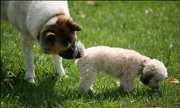 What we refer to as anal glands are really the sacs which hold the glands. They are also called anal sacs or scent glands because they release a strong smelling liquid which dogs and cats use to mark territory and identify one another. Animals also release this foul smelling liquid when scared suddenly.
What we refer to as anal glands are really the sacs which hold the glands. They are also called anal sacs or scent glands because they release a strong smelling liquid which dogs and cats use to mark territory and identify one another. Animals also release this foul smelling liquid when scared suddenly.
If an animal has healthy stools, the excretion of the stool will naturally push out anal sac fluids. If, however, your pet’s stools are constantly loose, anal fluid may back up, and the enlarged sacs can irritate the surrounding tissues.
In dogs, you will see:
- Butt-dragging
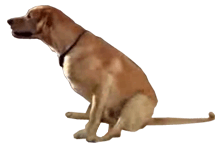
- Licking or biting the anus
- Sitting uncomfortably
- Tail-chasing
When cats have a problem with their anal sacs, they often will defecate outside their litter box, which can sometimes be misdiagnosed as a behavioral issue.
Impaction occurs when the duct from the anal gland to the opening gets blocked, trapping in the fluids. Symptoms include
- Pain
- Inflammation
- Fever
- Abscessation
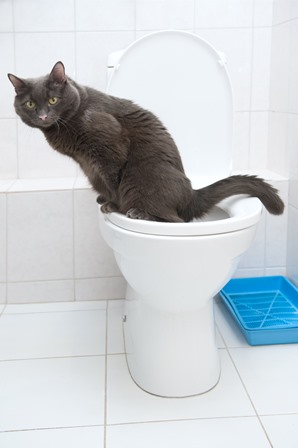 Infection often accompanies impaction. Note that the normal body temperature of a dog or cat is about 101.5°F. Anything below 100°F and above 103°F is cause for concern and you ought to contact your holistic veterinarian.
Infection often accompanies impaction. Note that the normal body temperature of a dog or cat is about 101.5°F. Anything below 100°F and above 103°F is cause for concern and you ought to contact your holistic veterinarian.
Healthy anal glands secrete a strong, malodorous, yellow or tan colored liquid. The material from impacted glands is thicker and darker. Blood or pus indicates an infection.
In healthy cats and dogs, you shouldn’t have to assist with anal gland secretion. Many groomers, however, believe that small dogs must have their sacs squeezed out, and they will empty the dog’s anal glands during every visit. But experts recommend only expressing a dog or cat’s anal glands if they are showing the symptoms of discomfort described above. Therefore, if you take your dog to a groomer, tell them not to express the dog’s anal glands unless you believe the dog is having problems taking care of that on its own.
Herbal and Naturopathic Help
If your dog is showing signs of anal sac build-up, you may want to do the excretion yourself. It’s not that difficult, but it is smelly. Put your dog in a tub or basin, because the fluid can squirt. Trim your nails, and use medical gloves. Lift the tail, and locate the sacs – they are roughly in the five o’clock and seven o’clock positions around the anus.
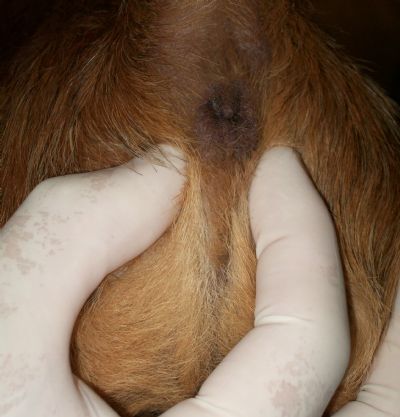 You will want to position your thumb and index finger in the shape of a claw or pincher, and press your fingers into and around the area of the sacs, or use all of your fingers as if you are trying to pick an orange off a tree. Apply pressure to the glands, gently squeezing them inward, then outward and upward. You’ll know when the glands are expressed.
You will want to position your thumb and index finger in the shape of a claw or pincher, and press your fingers into and around the area of the sacs, or use all of your fingers as if you are trying to pick an orange off a tree. Apply pressure to the glands, gently squeezing them inward, then outward and upward. You’ll know when the glands are expressed.
If, however, you suspect your pet has an infection, see a holistic veterinarian.
Anal gland problems are directly linked to the quality of your pet’s food. Feed a natural diet made from simple, wholesome, raw foods. This is, by far, the most important factor.
The consensus seems to be that adding fiber to the pet’s diet can help, because the roughage will cause bulky stools that will naturally push out the anal secretions. We disagree, though. While many animals do wonderfully on a natural diet that includes healthy grains, their bodies really weren’t designed to fully metabolize grain products. Their intestinal tracts are shorter than those of herbivores, 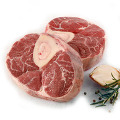 and are designed for the expedient metabolism of raw meat. Because of this physiology, grain products are often expelled before being fully digested, causing large, loose stools. Most pets have firmer stools when their diet is mostly comprised of raw meat, fat, and bones. We are not saying that grains shouldn’t be a part of your pet’s diet; we are saying that pets aren’t humans, and feeding them a bowl of bran flakes is not a good idea.
and are designed for the expedient metabolism of raw meat. Because of this physiology, grain products are often expelled before being fully digested, causing large, loose stools. Most pets have firmer stools when their diet is mostly comprised of raw meat, fat, and bones. We are not saying that grains shouldn’t be a part of your pet’s diet; we are saying that pets aren’t humans, and feeding them a bowl of bran flakes is not a good idea.
Do not feed cooked bones. The heat denatures the protein, which makes the bone tissue brittle and susceptible to splintering. And if your pet’s rectum is bleeding, don’t feed bones or indigestible objects that may have pieces that break off. These pieces can irritate the gastrointestinal tract, causing it to bleed. Most raw bones are good for your dogs and cats, though. See the section on bones on the Diet page.
Also, don’t feed your pet a diet solely made of meat. This is not good, either, for other reasons. See the Natural Diet section for more information.
A hot, moist poultice of chamomile, lavender, calendula or red clover tea will  also be helpful to empty and soothe the area. Test the temperature on the inside of your wrist to make sure it’s not too hot. Hold the poultice in place for roughly four minutes, change it, and then repeat.
also be helpful to empty and soothe the area. Test the temperature on the inside of your wrist to make sure it’s not too hot. Hold the poultice in place for roughly four minutes, change it, and then repeat.
Homeopathy
If the anal gland area is abscessed, give Belladonna 6c every four hours for three treatments. The following day, give
Silica 6x every four hours for twenty four hours.
If the anal glands are just impacted, give Silica 6x once per day for ten days or until the condition is rectified.